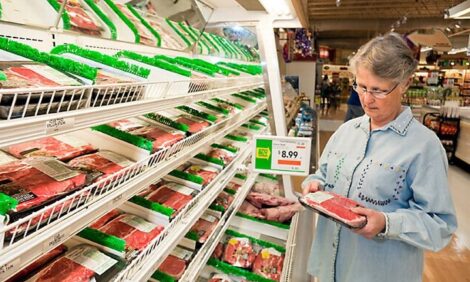



Study Finds New Genomic Regions Associated to Weight Gain in Nelore Cattle
BRAZIL - A pioneering research project has identified genes potentially associated with functions such as growth and weight gain in the Nelore breed. These functions are key to beef production. The researchers pinpointed genomic regions that had changed owing to selection, referring to these as genomic signatures of selection.A pioneering research project has identified genes potentially associated with functions such as growth and weight gain in the Nelore breed. These functions are key to beef production. The researchers pinpointed genomic regions that had changed owing to selection, referring to these as genomic signatures of selection.
"We found six genomic regions containing genes associated with weight gain in the Nelore breed. Some of these hadn't been reported in the scientific literature, even for other breeds of beef cattle," said Diercles Cardoso, a postdoctoral fellow of São Paulo State University's Agrarian & Veterinary Science School (FCAV-UNESP) at Jaboticabal, Brazil, with a scholarship from the São Paulo Research Foundation - FAPESP.
"Four of these regions are classified as signatures of selection and are in chromosome 14, which was already known to contain genes for growth in the bovine genome," Cardoso explained. "However, we identified two other signatures in chromosome 16. This was somewhat unexpected. It may be that genes in these two regions are associated specifically with growth traits in Nelore cattle and therefore offer immense potential for improvement of the breed in terms of weight gain."
Cardoso is lead author of an article published in the journal Genetics Selection Evolution presenting the results of his PhD research, which was supervised by Professor Humberto Tonhati. In addition to these two researchers, the study also involved Lucia Galvão de Albuquerque, Full Professor at FCAV-UNESP, scientists at the University of Göttingen in Germany, and researchers affiliated with the Animal Science Institute of the São Paulo State Agribusiness Technology Agency (APTA).
The identification of the genes began with the collection of blood samples from animals belonging to three Nelore selection lines maintained under an experimental program run by APTA's Beef Cattle Center at Sertãozinho, São Paulo State.
The program was set up in 1980 to show producers the benefits of selection for growth traits and evaluate the economic benefits of selection for growth on the overall productivity of beef cattle herds.
One of the three lines is a control and is not subjected to selection for weight gain. In the other two, known as Nelore Selection and Nelore Traditional, sires that perform best in weight gain tests are selected annually for reproduction. Every year, between three and eight of the best bulls are used for reproduction in the lines selected for weight gain (Selection and Traditional).
The FAPESP scholarship holder used blood samples from 782 animals born between 2004 and 2012 - 92 from the control line, 192 from the Selection line, and 498 from the Traditional line. The samples were processed in the laboratory to extract DNA and then submitted to genotyping, a process that examines the individual's DNA sequence to identify markers of genetic variation through single nucleotide polymorphisms (SNPs).
Using SNP chips, Cardoso analyzed DNA from all sampled animals and proceeded to compare the genotypes of animals in the control line with those of animals in the other two lines using three independent methods. The first identified 48 genomic regions that displayed signs of being linked to weight gain functions. The second and third methods identified only seven and 17 regions, respectively.
Cardoso compared the three sets of results and arrived at six regions that were identified by at least two of the methods. These were the six signatures of selection found to be associated with the animals' weight.
Cardoso now plans to study the functions of the genes in these regions in search of evidence that they are indeed associated with growth in Nelore cattle.
Taurine and indicine
All types of cattle breed belong to same species, Bos primigenius, which is divided into two subspecies, B. primigenius taurus (taurine) and B. primigenius indicus (indicine, zebu or humped). Animals of the former subspecies are better adapted to climates with harsh winters, as they gain weight in warm months, accumulating reserves to survive until winter is over and green pasture returns.
The Nelore cattle, which makes for 80 per cent of all cattle reared in Brazil, belongs to the indicine subspecies. B. primigenius indicus originated in India, located in the tropics - that explains Nelore cattle's well-succeded adaptation to Brazilian climate.
The other side of the coin is that being a tropical breed and not needing to gain weight in order to survive the mild winters in the tropics, Nelore is naturally lean and gains less weight than taurine breeds. Hence the need to find specific genes responsible for weight gain in Nelore.
Genomic database
The study was conducted under the aegis of the Thematic Project "Genomic tools for genetic improvement of economically important traits in Nelore cattle". As its coordinator, Albuquerque said that the project allowed for the deployment of a database for genotyped animals, including data on traits associated with beef quality.
"Enhanced quality of beef cattle means meat that's more tender and has more marbling, which is intramuscular fat, the intermingling or dispersion of fat within the lean, making the meat tastier.
"Brazilian beef is very lean because most beef cattle are free-range, allowed to graze in open pasture rather than being fattened in feedlots, and also because until now the Nelore breed hasn't been selected for meat quality. These traits need to be improved."
Between 2011 and early 2017, the Thematic Project invested in studies designed to help improve meat quality and enhance Nelore food efficiency - the capacity to convert food into weight gain.
"The idea is to obtain an animal that eats less, gains weight faster and produces high-quality meat. At the end of the project, we'd genotyped over 8,000 animals and measured a range of economically important traits such as food and reproductive efficiency, as well as meat quality," said the coordinator for the FAPESP-funded project.
TheCattleSite News Desk


